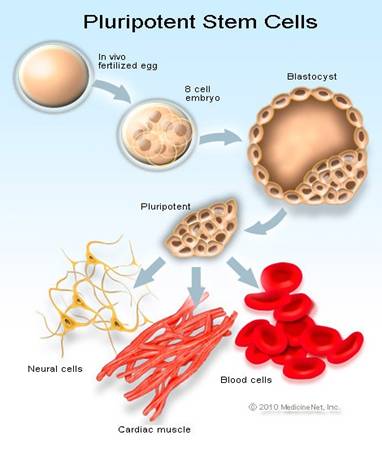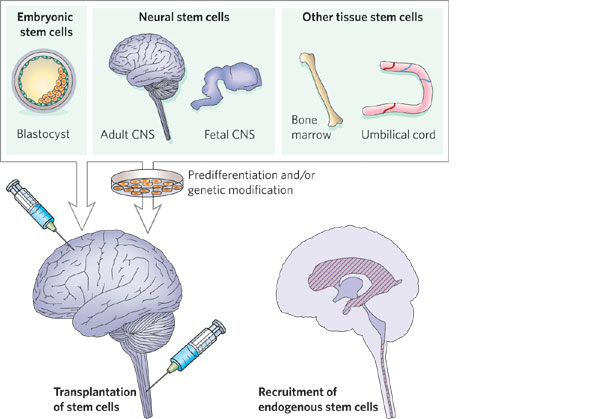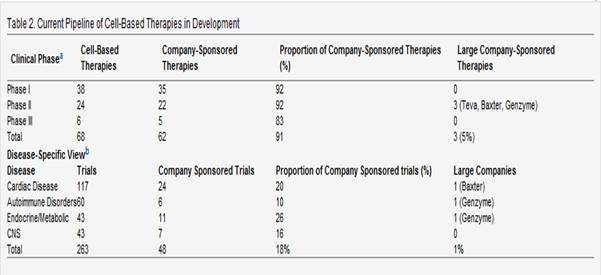The current advances in the biotechnological applications of stem cells
Stem Cells are unspecialised cells having the ability to form specialised cells. The most commonly used are the embryonic stem cells. In this review, I have talked about stem cells, their different types, their differences from other cell types, stem cell importance and how this can be used in application. As far as its application is concerned, I have selected a few diseases and discussed the role of stem cells in their treatment.
Introduction:
Stem cells are undifferentiated cells which have the ability to divide throughout lifetime and give rise to one of the many specialised (differentiated) cells. Stem cell can divide to either form stem cells or into different specialised cells like muscle cells, red blood cells or neural cells (Figure 1). Their main job is in the internal repair system, where they divide to regenerate other cells in the body which may have undergone wear and tear (National Institute of Health, 2009).

Figure 1: Differentiation of Stem Cells
Source: MedicineNet.Inc (2010)
How are stem cells different from other cell?
- They are unspecialised
- They can replicate via cell division
- They can be induced under certain physiological or experimental conditions to form tissue or organ specific cells; this is known as transdifferentiation (National Institute of Health, 2009).
Different types of Stem Cells
Stem cells can be obtained from animals and humans
- Embryonic Stem Cells
- Fetal Stem Cells
- Adult Stem Cells
- Peripheral Blood Stem Cells
- Umbilical Cord Stem Cells
- Induced Pluripotent Stem Cells (iPSCs) -> Adult cells genetically converted to embryonic stem cell like state (Stoppler, 2010).
Importance of Stem Cells
Stem cells can correspond to an exciting area in the field of medicine due to its ability to renew and repair impaired tissues. Currently, this principle is used in Bone Marrow Transplantation, and future investigation is going on to develop more therapies to transplant stem cells into damaged body parts and guide it to grow and differentiate into healthy tissue (Stoppler 2010). Human embryonic stem cells can be used to improve our understanding of human development. The basis of some lethal diseases like cancer and birth defects is uncontrolled cell division and differentiation, and by improving our knowledge on molecular and genetic control we can understand how these disease occur and thus suggest strategies for treatment. Stem cells can also be used in testing new drugs; they can be used to check their efficiency and safety on the pluripotent cells. Potential uses of stem cells are in the field of regenerative medicines to come up with cell based therapies to treat diseases like cardiac diseases and diabetes (National Institute of Health, 2010).
Application of Stem cells
Stem cells in liver regeneration
Liver failure is a lethal condition if left untreated. The only ultimate approach to treatment is organ transplantation. Due to the limited availability of liver, new approaches are needed to treat this condition. Cell therapy can be an effective solution for partial as well complete transplant. Therefore various investigations are being carried out to isolate stem cells and induce them to produce hepatocytes in vivo as well as in vitro. The cell numbers can be easily populated by increasing it in vitro and thus produce a large amount of cells from an initial few cells. Some of these cells are present in adults and therefore can be isolated from patients and used for producing “personalised immunologically matched hepatocytes” (Porada et al, 2010).
Hematopoeitic stem cells (HSC)
HSCs have the best ability to produce hepatocytes like cells in vivo and completely repopulate the liver after transplantation. HSCs can be derived from umbilical cord blood, bone marrow and mobilised peripheral blood. Studies have shown that HSCs from umbilical cord blood produce more hepatocytes as compared to others, with mobilised peripheral blood producing the least (Porada et al, 2010). Mesenchymal stem cells (MSC). MSCs have the ability to give rise to cells of all the three germinal layers (i.e. endoblast, ectoblast and mesoblast) (freedictionary.com) in vivo and in vitro. The number of cells can be increased in culture for longer periods without losing the capacity to differentiate. MSCs can be genetically modified at ease and produced from a patient’s own marrow, even if the liver is affected by disease due to enetic defect, and thus propagate large number of cells to attain engraftment. An additional benefit of using MSCs is that it can be used in extensive scales of injuries and diseases within liver (Porada et al, 2010). Endothelial progenitor cells. These cells are important in the repair of damaged/diseased liver using factors needed for endogenous hepatocyte repair mechanism. They can make new blood vessels using growth factors and engraft within an injured liver. Survival can be improved even in the case of serious liver injury. It can be used to prevent liver fibrosis and promote regeneration (Porada et al, 2010). These cells have shown a great potential in animal models. The results of human clinical trials are promising but yet not significant. With optimisation and standardisation of methods the result should improve.
Treatment of neurological disorders (Parkinson’s disease and Stroke)
Neurological disorders occur due to loss of neurons and glias (Lindvall, 2006). Stem cells have been used to create neurons and glias from cultures and thus setting a base for stem cell based transplantation therapies. Source of stem cells (Figure 2):
- Embryonic Stem cells
- Stem Cells from foetus or adult Central Nervous System
- Other tissues.
Figure 2: Application of Stem cells in neurological disorders.

Source: nature.com 2006
Stem Cells for Parkinson’s disease
Parkinson’s disease is a degenerative disease of the nervous system caused by gradual loss of neurons in substantia nigra where dopamine is produced (Hotton, 2005). Dopamine is a chemical messenger which affects the part of the brain which controls movement (University of Texas).
Current therapy:
Oral intake of L-Dopa and dopamine receptor agonist. These therapies are effective for some symptoms but are associated with side effects and do not stop the disease from advancing (Lindvall, 2006). Clinical trials have shown that transplantation of human fetal dopaminergic neurons leads to long lasting improvements in some patients (Lindvall, 2006). Therefore, cells with dopaminergic neuron properties have been produced from stem cells in vitro using ES cells and cells from fetal brain and bone marrow. For further improvement dopaminergic neurons with substantia nigra characteristics need to be produced for proper functioning and release of dopamine. (Lindvall, 2006)
Problems faced:
- Survival in animal model after transplantation with human dopaminergic has been poor.
- Strategies to stop the progression of disease are needed.
Stroke and Stem cells
Stroke occurs when the supply of oxygen is blocked to a certain part of the cell and thus neurons begin to die (Medicine.Net, 2010). It is usually caused by blockage of cerebral artery to focal ischemia (Lindvall, 2006).
Current treatment: Nothing.
Source of Stem Cell for transplantation:
- Neuroepithelial cell lines
- Fetal Brain
- Umbilical cord
- Bone Marrow
Human fetal neural stem cells were transplanted into rats affected with stroke which led to movement of new neurons towards ischemia lesion. Another study showed transplantation of embryonic stem cell derived progenitor led to reconnection with target areas (Lindvall, 2006).
Stem Cells and Gene therapy
Gene therapy is used for treatment of diseases which are caused by the malfunctioning of genes. Gene therapy is carried out by substituting the normal function of the defective genes by “inserting a normal copy of the target gene into non-specific location into host genomic DNA” (Brignier, 2009). Therapeutic gene is inserted into a “replication deficient virus” and then transplanted (Brignier, 2009). For non-dividing cells ike cardiomyocytes and neurons, non integrating virus like adenovirus can be used and for cells which can divide like stem cells either Ƴ-retrovirus or lentivirus can be used for transmission to daughter cells (Brignier, 2009).
Advantages of using Stem Cells for Gene Therapy
As stem cells can divide throughout their life, they decrease or abolish the requirement of recurring administration of therapeutic cells. Gene therapy can be used for the treatment of single-gene inherited diseases. The host’s own stem cells can be repaired by genetic engineering and used for “autologous transplantation” and thus reducing the risks of allogenic cells (Brignier, 2009).
Example of use of stem cells in gene therapy
Hematopoietic Stem cells were used in clinical trials of genetic immunodeficiency diseases like adenosine deaminase-deficient SCID and chronic granulomatous disease. The results were hopeful but a lot of cases reported development of leukaemia caused due to insertional mutagenesis (Brignier, 2009). Hemoglobinopathies such as β-thalassemia and sickle cell diseases are being studied for treatment using gene therapy.
Mucosal and skin stem cells are being used for treating junctional epidermolysis (Brignier, 2009).
Problems being faced:
- Control of protein levels in the absence of endogenous gene regulatory regions
- Gene expression maintenance for longer time
- Low protein productions
- Insertional mutagenesis resulting in leukaemia.
Advancement for overcoming some problems:
- To enhance efficiency and to eliminate insertional oncogenesis, new techniques are being developed, e.g. lentivirus transduces non-dividing cells easily and induces lower mutagenesis than Ƴ-retroviruses.
- Homologous recombination for correcting the direct gene is being improved.
Future Works:
Mesenchymal stem cells can be used in tumour specific therapy because of their tendency to move towards tumours. The research is ongoing to develop an appropriate cell-based delivery vehicle (Brignier, 2009).
Stem Cells and Diabetes:
Diabetes mellitus affects 250 million people worldwide (Guo, 2009). It results when the body is incapable of producing sufficient quantities of insulin, which regulates blood glucose.
Current treatment: Exogenous supply of insulin.
Stem cell treatment:
- Complete pancreas transplantation
- Purified islets are transplanted to repopulate insulin producing cells
The second method has the advantage over whole organ replacement, of being less invasive and with fewer complications. It also comes with some drawbacks, like there is no long-term insulin independence. When combined with exogenous insulin supply, it helps in controlling glucose level in the blood (Guo, 2009).
Stem Cell source:
Embryonic Stem cell, they are known for maintaining their characteristic dividing property after proliferation and thus can be expanded to a large number. The problem with these cells is that the directed differentiation to form insulin secreting cell is difficult because there is a need to control the amount of unwanted cell types and they produce lower level if insulin as compared to the natural cells (Guo, 2009)
HSCs as compared to ES cells, produce a lower number of cells and a lower amount of insulin (Guo, 2009). They can be triggered to produce a large number of insulin producing cells by mimicking the signalling in vitro which occurs in natural differentiation.
Pancreatic duct:
When cells isolated from the human pancreatic duct were cultured, they could be differentiated into ductal as well as endocrine cells. After a few days, the cells were observed to secrete low levels of insulin when subjected to a small concentration of glucose, thus the cells were subjected to a higher concentration of glucose and a higher secretion of insulin was observed. This was possible due to association of islets with pancreatic ductal epithelium during organogenesis; this was proved in a separate study (Mohan et al 2006).
Other sources of stem cells include adult stem cells from pancreas, foetal tissue, bone marrow, liver cell and enterocyte ( since intestine and liver share the same embryonic origin with the pancreas in the primordial gut) (Mohan et al, 2006).
Conclusion:
It can be seen with growing advancement in technology, the application of stem cells is increasing day by day. There is an increased interest in stem cells from pharmaceutical companies as well (Table 1).

Table 1: Cell based Therapies in development and companies involved.
Stem cells have varied applications in the treatment of various diseases, but the underlying concept behind all remains the same i.e. a single cell type possessing the ability to divide into large number into several different types of cell. The application of stem cells is increasing tremendously, especially that of Embryonic Stem cells. The introduction of induced pluripotent stem cells opened the door for personalised regenerative medicines. The ultimate promise of stem cells seems to be cell/ tissue replacement therapy. This will be of more importance when pharmaceutical companies shift their focus from just treatment to disease modification (McKernan et al, 2010). The success mantra for stem cells seems to be cost effectiveness, patient safety and a clear detailed understanding of human biology.
References:
Brignier, A.C. (2009) Embryonic and adult stem cell therapy. American Academy of Allergy, Asthma & Immunology 125:336-334.
Guo, T., Hebrok, M. (2009) Stem cells to Pancreatic β-cells: New Sources for Diabetes Cell Therapy. The Endocrine Society 30(3):214-227
Hotton,G., Chaudhari,K.R. (2005) Parkinson’s Disease. Net Doctor [online]. Available from http://www.netdoctor.co.uk/diseases/facts/parkinson.htm (accessed on December 8th 2010).
Lindvall,O. , Kokaia,Z. (2006) Stem Cells for the treatment of neurological disorders. Nature 441:1094-1096.
Mohan,V. et al (2006) Stem cells and Diabetes. Current Science 91:1158-1165.
McKernan,R. et al (2010) Pharma’s Developing interest in Stem Cells. Cell Stem Cell 6(6): 517-520.
National Institute of Health (2009) Stem Cell Basics: Introduction. Stem Cell Information [online]. Available from: http://stemcells.nih.gov/info/basics/basics1 (accessed on December 7th 2010).
Porada,G.A. et al (2010) Bone marrow stem cells and liver regeneration. Society for Hematology and Stem Cells 38(7):574-580.
Stoppler,M.C.(2010) Stem Cells. Medicine.Net [online]. Available from: http://www.medicinenet.com/stem_cells/article.htm#what (Accessed on December 7th 2010).
University of Texas Dopamine: A Neural transmitter. Available from: http://www.utexas.edu/research/asrec/dopamine_p.html (accessed on December 8th 2010).